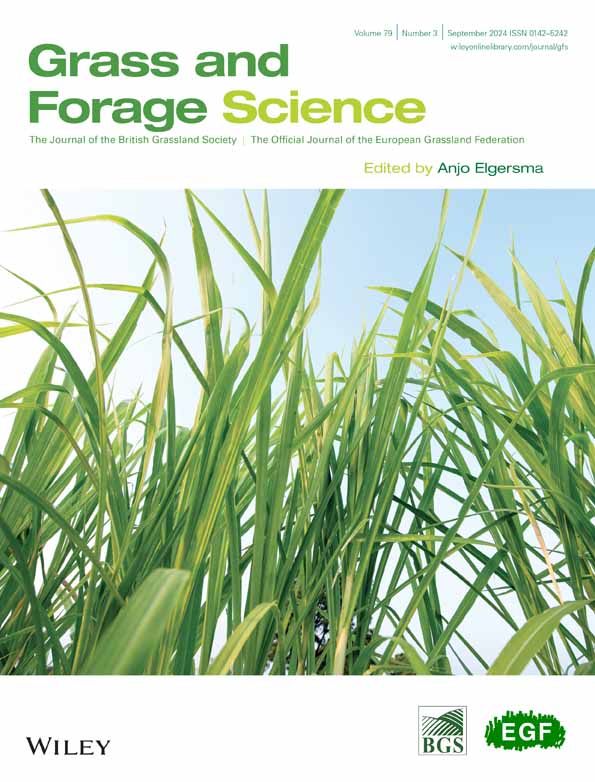The de-domestication of Ornithopus sativus Brot. to develop cultivars with physical dormancy (hardseed)
Abstract
Ornithopus sativus Brot. (French serradella) is a forage legume that is well adapted to acidic coarse textured soils (sands) which are characterized by poor nutrition and an inability to retain water. During the process of domestication of O. sativus, there was an unintentional loss of seed physical dormancy (PY) thus compromising its self-regeneration after a cropping interval. Through mass screening of seed, we identified for the first time that heritable sources of PY exist in three populations of O. sativus. This rare genetic material was then incorporated into suitable genetic backgrounds of differing maturity through targeted hybridization. We demonstrated that the heritability of PY was dominant in the population of 97ZAF5sat but inconsistently recessive in the population of cv. Emena. Flowering time was variable in each source population, with a large variation in time to emergence of first flowers (95–175 days). Selection for early flowering maturity was heritable and stable. F6 generations selected for PY in different maturity classes were then evaluated in situ to establish whether PY would allow a proportion of seeds to survive in the soil through consecutive seasons exposed to a Mediterranean climate. The breeding lines FHS3, 7 and 23 remained dormant, thus viable, in the soil for up to 3 years, indicating the likelihood that O. sativus with PY could survive and persist in a ley farming system. The de-domestication program in O. sativus has resulted in commercially successful cultivars (most recently cv. Fran2o) suited to sustainable dryland agriculture in a Mediterranean climate.
1 INTRODUCTION
In most species of the Papilionoideae, the timing and extent of seed germination is controlled by physical dormancy (PY) induced by the development of a water impermeable seed coat (Baskin & Baskin, 2014). Absolute PY is generated by low seed moisture content (Gama-Arachchige et al., 2013; Geneve et al., 2018; Hyde, 1954; Jaganathan, 2016; Jayasuriya et al., 2009). This type of PY is often referred to as “hardseed” or being “hardseeded”, where the failure to germinate in suitable conditions protects the seed from germination at a time that is not advantageous for survival.
Plant domestication is the conscious or unconscious selection of morphological traits for cultivation (Harlan, 1986; Vavilov, 1926; Zohary, 2004). These plants then differ from their wild progenitors usually in relation to seed retention, seed dormancy, growth habit, colouration, yield and/or edibility (Abbo et al., 2017). There is considerable selection pressure away from PY when seed is harvested upon ripening, stored under mild conditions and then sown into moist soil for further seed production, especially in pulse legumes (Ladizinsky, 1987). Under this regime, seed may not be exposed to dormancy releasing conditions; only seeds that readily germinate will reproduce (depending on maturity), be harvested in that season and contribute to the next generation populations (Abbo et al., 2009; Harlan et al., 1973; Zohary et al., 2012). For example, pulse legumes such as Lens culinaris L. and Pisum sativum L., when cultivated through the early Neolithic period, had intense selection to remove the seeds that possessed an inhibition of germination (Zohary et al., 2012). This outcome, in effect, is part of the domestication process in plants which progressed civilisation (Abbo et al., 2014; Diamond, 2002). We contend that the forage legume O. sativus Brot. lost its PY trait in a similar fashion.
Another important factor in the adaption of any given species to an environment is the timing of flowering (Weller & Ortega, 2015) which is currently viewed as an important trait to assist plants to manage a changing climate (Nelson et al., 2010). Matching flowering time to the target environment in a dryland farming system allows the production of mature seed before soil moisture becomes the limiting factor in spring (Vadez et al., 2012).
Domestication of exotic forage legumes began in southern Australia in the mid-20th century (Donald, 1970), when forage scientists sought improved traits, especially lower oestrogens in T. subterraneaum (Francis & Millington, 1965). Later, a second generation of hard seeded, climate resilient plants were developed that better suited the pressures of contemporary dryland ley-farming (Howieson et al., 2000; Loi et al., 2005). Ornithopus L. emerged as a promising genus in this period (Gladstones & Barrett-Lennard, 1964). Commonly referred to as serradella or birds-foot, this genus is consistent with the pattern of plants harbouring the PY trait in wild forms, but not in cultivated/domesticated forms (Barrett-Lennard & Gladstones, 1964). There are six recognized species of Ornithopus all of which, apart from O. sativus, are wild species with a ruderal ecology that normally produce high levels of PY. O. sativus has been cultivated for fodder in Europe for many hundreds of years (Klinkowski & Griesinger, 1939). Its centre of origin is believed to be on the Iberian peninsula and its cultivation has been reported through France and Belgium to north and eastern Germany, Poland and western Russia, with no seed dormancy reported (Gladstones & Barrett-Lennard, 1964; Schofield, 1950).
An Ornithopus species that contains high levels of PY and adapted to acid sandy soils, O. compressus L., was discovered suitable for ley-farming relatively recently (Barrett-Lennard & Gladstones, 1964; Gladstones & Devitt, 1971), with its success in Western Australia linked to naturalized soil populations of its micro-symbiont, Bradyrhizobium spp. (Stępkowski et al., 2005). However, this species houses its seeds in a woody pod, and the limited segmentation of these pods, combined with a hook on the terminal beak, complicated its bulk handling to the point where seed production became very expensive (and therefore unprofitable). Aware of this constraint, senior breeder Dr Bradley Nutt evaluated limited germplasm of O. sativus in a parallel program (Nutt, 2010). The release in 1995 of cv. Cadiz confirmed that pods could be harvested in one-pass directly using a conventional cereal harvester, that these pods would segment (Figure 1) with minimal processing, and that these segments could be sown without further processing to produce highly productive pastures (Nutt & Paterson, 1997).
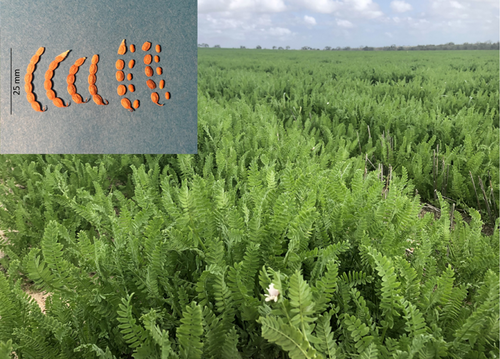
However, in the contemporary ley farming systems of southern Australia, forage legumes are only established once every few decades (Hackney et al., 2015), and are expected to self-regenerate through several cropping phases from pools of PY seed which lie dormant in the soil (Loi et al., 1999; Taylor, 2005). This confers both economic and bio-physical sustainability on the farming system. Soil is not cultivated in the pasture phase, during which soil carbon is increased (Lal, 2004; Mann, 1986; Möller, 2015), and biological N fixation from this phase can be sufficient for production of high protein cereals grown in rotation, reducing the requirement for application of ammoniacal fertilizers (Harrison et al., 2023; Loi et al., 2022). Despite their utility as a forage legume, domesticated forms of O. sativus are clearly unsuited to this form of agriculture because their seeds all germinate (within the pod segments) during a cropping interval and are terminated by selective herbicides. To the point where there are insufficient seeds remaining to germinate in the next pasture phase (in the absence of the PY trait). Therefore, in this manuscript, we describe the breeding effort aimed at re-introducing PY into populations of O. sativus, viz; the de-domestication of the non-dormant trait in O. sativus.
- Seek evidence of heritable PY in different populations of O. sativus,
- If the PY trait is discovered, examine the pattern of PY release by the environment to establish its suitability for persistence in a Mediterranean dryland ley-farming system, and,
- Determine if there is variation in flowering time maturity within populations of O. sativus, to expand the cultivation of this species across different environments, and
- To determine if the PY and early maturity traits could be combined.
2 MATERIALS AND METHODS
2.1 Mass selection to identify seeds with PY in O. sativus
A total of 20 kg of pod segments of O. sativus cv. Cadiz was produced commercially under licence and held in the Australian Trifolium Genetic Resource Centre (ATGRC), Perth, Western Australia. Each pod segment normally contains a single viable seed which germinates through the seam in the dehiscent pod segment after it has been exposed to moisture for several days (dependent on temperature). A sample of 500 g of pod segments (see Figure 1 inset) was randomly selected and oven dried at 40°C for 3 days. Paper towel of A4 dimensions was moistened with sterile DI water from a spray bottle and a line of approximately 100 pod segments (containing 50 seeds) was placed 3 cm from the bottom of the paper towel. This was repeated 10 times, with the lines of pod segments moving up the towel, approximately 3 cm apart. A vertical side section (2 cm) of the paper towel was folded, and the paper towel then gently rolled from the bottom into a tight cylinder, secured by two elastic bands and placed vertically on the folded section into a plastic container (30 × 20 cm × 10 cm (h)) holding sterile water 1 cm deep. This process was repeated 50 times as described by Nutt (2010) to screen large numbers of segments in an unbiased methodology until the containers were packed with vertical cylinders of pod segments encased in paper towels. The apparatus was then enclosed in plastic film and placed in the dark at 15°C in a humidity-controlled environment for a 28-day period, during which time the paper towel remained moist due to the “wick” effect.
2.1.1 Germination protocol
The paper towel containing pod segments was carefully unrolled twice over a 28-day period, and any germinated seeds (and pod segment residues) were removed after seven and 14 days to minimize microbial decay. After 28 days, any remaining un-germinated seeds in pod segments were considered potentially dormant and set aside for further study. This process screened approximately 50,000 pod segments for the presence of dormant seed.
2.1.2 Mass selection for alternative genetic sources of PY in O. sativus
Two additional sources of O. sativus were examined for presence of PY. Ecotype 97ZAF5sat was collected from Darling, Western Cape Province, South Africa (latitude 33° 22′ S, longitude 18° 21′ E, altitude 200 m). This ecotype had been grown for characterization by the ATGRC and stored. 97ZAF5sat was selected as a base population for its early maturity, pod retention to the stems at senescence and a capacity for high seed yield compared to available germplasm. The second source, cv. Emena, is a landrace in the Western Cape Province, Republic of South Africa, which had been successfully cultivated as a cover crop from the early 1990's (Fourie et al., 2005). The cultivar Emena was sourced from commercial South African supplies.
Samples from 500 g of pod segments representing both sources of O. sativus held by the ATGRC were dried at 40°C for 3 days then placed on moist paper towel at 15°C for 28 days to germinate, as described above. Any seed that did not germinate was considered potentially dormant and subsequently recovered.
2.1.3 Plants grown from potentially dormant seeds
Seeds that did not germinate were removed from 29 pod segments of cv. Cadiz, and 40 pod segments each from both 97ZAF5sat and cv. Emena, scarified by gentle rubbing on sandpaper, then grown as single plants at Medina Research Station (latitude 32° 13′S, longitude 115° 48′ E). Observations were taken for maturity (days to first flower), vigour, pod yield and pod retention as described by Nutt, Harrison, et al. (2021). Pod produced from plants grown from Cadiz were then allocated into cohorts of similar maturity and morphology, for further generations of seed increase. All generations of seed were subject to the PY test as described in Section 2.1.1. Plants grown from dormant seeds of acc. 97ZAF5sat and cv. Emena formed the basis of PY for future hybridization studies (referred to as S1 -meaning selection cycle 1). Seeds produced by S1 plants were grown to maturity at Medina Research Station and these included plants which had produced more than 90% dormant seed and two plants which produced no dormant seed from the 97ZAF5sat population, and 10 plants ranging from 0% to 85% dormant seed from the cv. Emena population. These plants were classified as the S2 generation. For each of these plants, 30 offspring were grown as fully randomized spaced plants. Not all 30 offspring of each selection were harvested, as strong winds at senescence detached some plants from the ground, which obscured their identification. The S2 progeny were subject to the PY test as described in Section 2.1.1.
Hybridization of selected dormant-seeded S2 plants was then undertaken (described in Section 2.3) to understand the genetic control of PY as described by Nutt (2010) and Nutt, Harrison, et al. (2021).
2.2 Selection for early maturity in cv. Cadiz
Simultaneously, a bulk planting of single-spaced plants of cv. Cadiz, was undertaken at Medina Research Station to search for early flowering variants. The first 13 of approximately 6000 Cadiz plants to present open flowers, after sowing in early winter, were isolated by carefully transplanting into pots in a sealed glasshouse, and then grown to maturity for seed production. Isolation was undertaken to ensure self-pollination. A total of 30 single-spaced plants from each of these individuals were grown in blocks at Medina Research Station the following season. The number of days from germination to the production of the first open flower was recorded for each individual plant. After plant senescence, the pods were hand stripped from the vines, dried and stored. A bulk, single row of each of the five families that exhibited the greatest and most stable change to early maturity were grown the following season, at the same location.
2.3 Hybridization of O. sativus plants to combine PY sources with differing maturity levels
Parent plants were chosen from the 97ZAF5sat population based upon their PY and early flowering traits (A1), and from cv. Emena as a source for later maturity combined with moderate dormancy (B1). They were chosen based on consistent expression of these traits in their progeny, as well as features such as pod retention, pod yield (to ensure no inbreeding depression) and growth habit. The earliest flowering selection from cv. Cadiz, and cv. Cadiz itself, were used as early flowering, soft-seeded (D1) and late flowering, soft-seeded (C1) parents in hybridization, respectively (Table 1). These plants were grown in a general potting mix in the glasshouse until flowering, when 97 hybridisations were attempted. These attempts included reciprocal crosses, using the procedures described by Nutt (2010) and Nutt, Harrison, et al. (2021). For successful putative crosses that produced viable seed (termed F1, with the F meaning filial generation), the seeds were collected, scarified then germinated and grown under controlled conditions in the glasshouse to ensure self-fertilization. The resulting plants were grown through to maturity and seeds collected (the F2 generation) as described by Nutt, Harrison, et al. (2021).
| Cluster and S1 plant | Parent (S1) PY (%) | Offspring (S2) classified as | |||||
|---|---|---|---|---|---|---|---|
| PY (>1% hard seeds) | No PY (≤ 1% hard seeds) | ||||||
| Number of S2 plants assessed | Mean PY (%) | Variance | Number of S2 plants assessed | Mean PY (%) | Variance | ||
| A1.1 | 97 | 29 | 98.6 | 1.9 | 0 | - | |
| A1.2 | 96 | 24 | 98.9 | 6.7 | 1 | 0 | - |
| A1.3 | 96 | 26 | 97.4 | 8.1 | 4 | 0 | 0 |
| A1.4 | 96 | 29 | 98.4 | 3.0 | 0 | - | - |
| A1.5 | 95 | 29 | 95.3 | 22.2 | 0 | - | - |
| A2.1 | 0 | 7 | 98.0 | 2.8 | 23 | 0 | 0 |
| A2.2 | 0 | 2 | 96.8 | 10.1 | 26 | 0.1 | 0.1 |
| B1.1 | 88 | 12 | 75.2 | 234.3 | 0 | - | - |
| B1.2 | 81 | 28 | 83.8 | 330.0 | 0 | - | - |
| B1.3 | 72 | 21 | 83.9 | 123.6 | 0 | - | - |
| B1.4 | 70 | 18 | 41.9 | 453.9 | 0 | - | - |
| B1.5 | 26 | 15 | 9.6 | 239.3 | 6 | 0.5 | 0.2 |
| B1.6 | 22 | 28 | 10.0 | 102.5 | 2 | 0.8 | 0.1 |
| B1.7 | 14 | 30 | 16.6 | 246.4 | 0 | - | - |
| B1.8 | 6 | 29 | 14.6 | 157.4 | 0 | - | - |
| B1.9 | 4 | 24 | 8.3 | 138.4 | 6 | 0.8 | 0.1 |
| B2.1 | 0.5 | 0 | - | - | 26 | 0.1 | 0.0 |
A total of 960 F2 plants from the top 10% highest seed yielding F1 plants were grown at Medina Research Station as single-spaced plants in a fully randomized design (Figure 2) during the following growing season. White plastic matting was laid between plants to suppress weed competition. Days to first open flower from sowing were recorded and senesced plants were harvested over the first week of December.
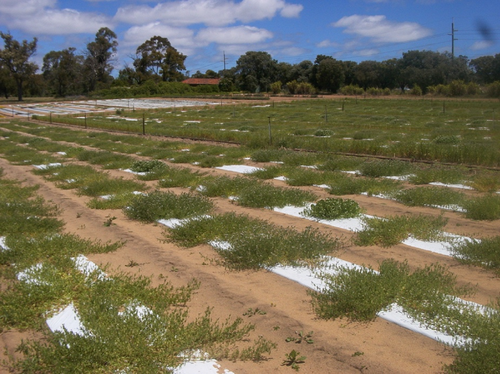
2.4 Germination tests to identify dormant seed produced by the F2 generation
Germination tests to reveal if progeny contained the dormant PY genetics were conducted as previously described, on both the F1 and F2 generation plants. Because of the high numbers of genotypes involved in the F2 generation, a single sample of 25 pod segments per plant was assessed for germination; viable imbibed and residual dormant seed were counted after 28 days. In all cases the proportion of dormant seed was calculated as above. Dead seed or abnormal seedlings were infrequent and not included in any analyses. Progeny were grouped into categories either possessing PY (>1% dormant seed) or not (≤1%).
2.5 Verification of PY in situ by burying pod segments in the soil
Assessment of the PY trait and its pattern of dormancy release over several years was undertaken at two locations in the wheatbelt of Western Australia. This general region is described as possessing a hot, dry Mediterranean climate with winter dominant rainfall, normally commencing around April, with rainfall uncertain after September.
2.5.1 Field exposure of putative PY lines selected from cv. Cadiz
To produce the pod material required for this study, two cohorts emanating from the original dormant seed selections in cv. Cadiz, FHS3 and FHS7 (FHS = French Hard Seed), were grown in small swards which were allowed to mature naturally under rain-fed conditions. Harvested pod was stored at ambient temperature until preparation for the experiment. Pod of O. compressus cv. Santorini, a successful legume in ley farming in the low rainfall region, was sourced commercially. This specific cultivar of O. compressus was selected due to its unique pattern of PY release, where the release from dormancy is staggered, not uniform and succinct (Revell & Taylor, 1998).
2.5.2 Pod segment burial in soil, and their retrieval over time
The clean pod samples produced above were mixed thoroughly and split using an Encott two-way sample divider and counted into 100 pod segment lots. These were placed into plastic coated, fibreglass mesh (fly-wire) formed into pockets (each 5 × 3 cm), connected in strips of 10–15 pockets, and then sealed closed with a heat-sealer (see Harrison, Howieson, Yates, et al. (2021) for details). Each strip of pockets contained a randomized replicate of all treatments. Four replicates were buried under soil at 1 cm depth in January (mid-summer), at Medina Research Station in a randomized block design. The site of field exposure was an un-shaded area of loamy sand, which was kept free of plants or dry residue over the course of the experiment.
The mesh pockets were retrieved on three occasions after three summers of burial; 166, 520 and 876 days after being placed in the ground. These retrieval times were in winter in three successive years, during which time non-dormant seeds would have germinated. All material was removed from the mesh pockets, with the sand and debris discarded. The remaining non-germinated pod segments or whole pods were counted, then placed onto moist paper towel, as described previously. These were then transferred to a room held at 16°C, to provide conditions for germination to check for those seeds whose dormancy had been broken during the intervening period of burial. The seeds were checked for germination at regular intervals over 3 weeks. The criterion for germination was an emergence of a radicle. Any seed that had not imbibed after 28 days was considered to have PY for the duration of the burial period. A separate subsample was assessed for initial PY levels at the commencement of the experiment, prior to burial.
2.6 Field exposure of F6 hybrid progeny containing the PY trait from both 97ZAF5sat and cv. Cadiz
Again, using the buried mesh pocket approach (Section 2.5.2), an experiment was established at Murdoch University, Perth, Western Australia (32°13′07.52′′E, 115°50′24.69′′S) to evaluate an early maturing genotype FHS23 (PY genetics originating from 97ZAF5, with early flowering from Cadiz), against FHS7 (PY genetics originating from cv. Cadiz). Pod (F6) was produced the previous year at the same site. The experiment had four replicates with four retrieval times.
2.6.1 Dormant seed in the early maturing selection FHS23
FHS23 flowers 10 days earlier than FHS7 (in Medina, WA). Genotypes FHS7 and FHS23 were compared with a cultivar of Medicago truncatula (cv. Caliph) (which possesses dormant seed and had hitherto been a successful legume in ley farming in the low rainfall region), and an experimental line of O. pinnatus (acc.87GEH83a). The experiment was established in fields at Murdoch University during early February. At this site the minimum and maximum temperatures range from 18.5 to 31.6°C in February to 18.1–30.3°C in March. Soil parameters, maintenance and methods (including germination) were presented in Harrison, Howieson, Yates, et al. (2021). The retrieval times were 129, 494, 859 and 1234 days after the mesh pockets were buried at 1 cm in the soil, representing four successive opportunities for winter germination after softening over the previous summer/autumn, and pod segments were treated as described above.
2.7 Statistical analysis
The second generation of selections for PY from cv. Emena, Cluster B1, were compared by analysis of variance using maternal parent and germination test sample (two per plant) as factors and days to first open flower as a covariant. Differences in time to produce an open flower between offspring of the early flowering selections and cv. Cadiz were compared using a two-sided Student's T-test. Parent and hybrid times to flower were compared and environmental variance estimated using a one-way analysis of variance. Parent and segregating F2 populations were categorized for dormant seed score using group average cluster analysis. These groups were then compared using a two-way analysis of variance using dormant seed score group and parentage as independent factors. All analysis of variance, correlations and regressions were conducted using Genstat – Ninth Edition Version 9.2.0.152 (VSN International Limited).
For the investigation of selected genotypes for field-based confirmation of PY and its pattern of breakdown a generalized mixed model (function lmer in package lme4) (Bates et al., 2019) with family binomial (logit link) was performed. The percentage of physical dormancy was the response variable, treatments were fixed effects and block effect was a random effect to account for dependency in the data. Residuals were visually assessed to ensure the model assumptions were met. The Akaike Information Criterion (AIC) was used in model selection where appropriate. The function emmeans from package emmeans (Lenth, 2016) was used for post-hoc testing using the Tukey method of p value adjustment and the kenward-roger method of calculating degrees of freedom. Fitted values, 95% confidence intervals and comparison bars (based on Tukey method) were extracted from models using the emmeans function from the package emmeans (Lenth, 2016) and plotted with package ggplot2 (Wickham et al., 2016). Comparison bars represent Tukey pairwise comparisons between treatments and where the bars overlap there is no significant difference between treatments.
3 RESULTS
3.1 Discovery of PY within cv. Cadiz by recovering seeds that did not germinate within pod segments when saturated
From approximately 50,000 pod segments rolled into moist paper towel, 29 putative dormant seeds were identified. After these 29 seeds were scarified, germinated and grown to maturity, the harvested pods were assessed for PY. A total of 15 seeds produced plants whose offspring were determined to possess at least some PY, whilst the other 14 plants produced offspring with no evidence of PY. The former were bulked into cohorts based upon similar physiological features (habit, flowering time, pod yield, pod retention and vigour) and coded as FHS1-7 for further evaluation in the field.
3.2 Selection for PY from additional sources of O. sativus to provide genetic diversity for the PY trait
Dormant seeds were identified in both the populations of 97ZAF5sat and cv. Emena through the mass selection paper towel methodology. A total of 40 dormant seeds from each source were randomly selected, scarified, then germinated and plants were grown to maturity. Seeds produced in the second generation were tested for the PY characteristic. Not all plants selected produced PY, and the distribution of individual plants for the percentage of PY seeds differed between the populations (Figure 3). Plants from the population of 97ZAF5sat produced either a high proportion of PY or no PY at all. The selections from cv. Emena produced a broad distribution in the proportion of PY with a few individuals producing no PY. Plants grown from 97ZAF5sat consistently produced flowers earlier than those from the cv. Emena, with averages being 115 ± 1 and 137 ± 1 days after sowing, respectively (Figure 4).
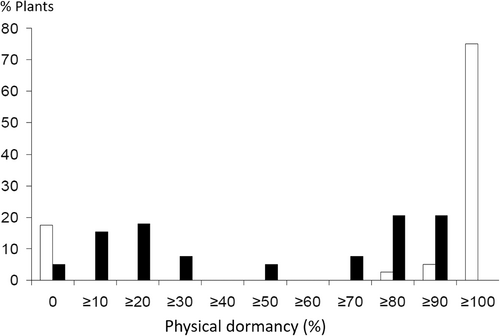
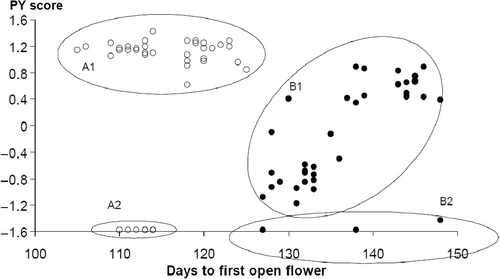
- Cluster A1 from accession 97ZAF5sat, consisting of individuals producing high levels of stable PY (average 95%) with no apparent relationship with maturity (R2 = 0.06).
- Cluster A2 from accession 97ZAF5sat, with individuals producing no PY.
- Cluster B1 from cv. Emena, which produced unstable proportions of PY (average 49%) and a significant positive relationship with maturity (corr. = 0.83, R2 = 0.68, p ≤ .05).
- Cluster B2 from cv. Emena, which produced no PY.
The next generation (offspring from a subset of 445 plants) from Clusters A1, A2 and B1, and a single plant from Cluster B2, produced a similar distribution of PY and flowering time to the source population clusters. In the 97ZAF5sat selections, when variance in the proportion of PY produced by a plant occurred, it was a discrete segregation. Some of the offspring from two of the five 97ZAF5sat sourced selections from Cluster A1 produced no PY even though their maternal plants produced high proportions of PY (Table 1). Conversely, the two individuals from 97ZAF5sat that produced no PY, from Cluster A2, segregated in the second generation, with some offspring producing high proportions of PY.
Segregation for production of dormant seed was less distinct among the subset of plants selected from the cv. Emena. Offspring from plants in Cluster B1 (nine plants) reproduced the wide distribution for the proportion of PY observed in the S1 generation. In general, within this Cluster B1, parent and offspring PY score were highly correlated (0.85) and maternal plant accounted for 63% of the total variation. However, some offspring of the Cluster B1 maternal parents had considerably higher and lower PY scores compared to the mean of their maternal siblings. All offspring grown from the single maternal plant from Cluster B2 produced no or very few dormant seeds (Table 1).
Considering both source populations from 97ZAF5sat and cv. Emena together, time taken to flower in offspring was highly correlated to that expressed in the maternal parent (corr. = 0.95, R2 = 0.91).
3.3 Selection for early flowering from O. sativus cv. Cadiz to provide genetic material suited to drier environments
Offspring from the isolated early flowering selections from cv. Cadiz produced open flowers on average 7 days earlier than the parent population with the same time of sowing (p ≤ .01). Selection D1 began flowering 12 days earlier than Cadiz. Within each early flowering selection there was little variation in the timing of flowering particularly considering the variation in the source cv. Cadiz population. The difference from Cadiz and the early selections was confirmed in a third generation grown as a single bulk row; however, this cannot be compared statistically. None of the early flowering selections produced evidence of the PY trait after senescence (data not shown).
3.4 Hybridisation between selected parents to combine PY with differing maturity grades
A schematic representation of the attempted hybridization between selected parent lines is presented in Figure 5. Parent A1 provided consistent high levels of PY from 97ZAF5sat, while B1 provided moderate and variable PY from cv. Emena. Parents C1 and D1 provided variation in maturity in the absence the PY trait. After flowers were manipulated for hybridization (Nutt, Harrison, et al., 2021), parent plants were transferred to the glasshouse and allowed to produce self-pollinated seeds for assessment of PY.
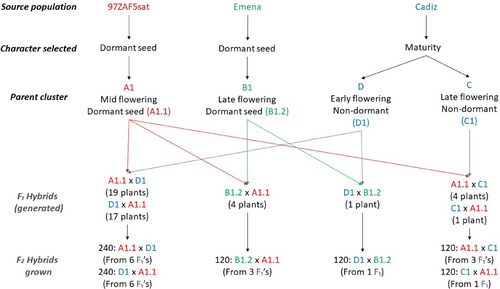
3.4.1 Hybrid progeny states of expression and segregation
Of 97 attempted hybridizations between these parental lines, 14 were successful and resulted in one to six seeds per flower and 45 seeds in total. Germination and dormancy were consistent with the maternal parent phenotype in the offspring (Table 2). All F1 hybrids of the early flowering, dormant seeded parent A1.1 produced high levels of PY when A1.1 was used as the maternal parent. However, when A1.1 was used as the pollen source in hybridization with the non-dormant parent D1, no progeny carried PY. Although parent B1.2 was selected for dormant seed production, both its self-pollinated offspring and single F1 hybrids with the early flowering, non-dormant parent (D1) produced little or no dormant seed when grown in the glasshouse over summer.
| Parentage | PY | Non-PY |
|---|---|---|
| Self-pollinated offspring | ||
| A1.1 | 8 | 0 |
| B1.2 | 0 | 8 |
| C1 | 0 | 8 |
| D1 | 0 | 8 |
| F1 cross pollinated offspring (maternal × paternal) | ||
| A1.1 × D1 | 19 | 0 |
| D1 × A1.1 | 0 | 17 |
| A1.1 × C1 | 4 | 0 |
| C1 × A1.1 | 0 | 1 |
| D1 × B1.2 | 0 | 1 |
| B1.2 × A1.1 | 4 | 0 |
The level of PY in the seeds of the second-generation progeny of the parents was consistent with the first generation, except for B1.2 which segregated for this character (Table 3). The pattern of segregation in F2 hybrids for production of dormant seed was different for the two sources A1.1 (97ZAF5sat) and B1.2 (cv. Emena) (Table 3). The early flowering parent with PY (A1.1) when hybridized with both non-dormant seed parents (C1 and D1), segregated in a bimodal pattern in the F2 generation, producing either high levels of PY or no PY. The late-flowering parent that contained no PY (C1) generally produced F2 hybrids with lower levels of PY than the early flowering parent D1 (mean PY score of A1.1 × C1 and C1 × A1.1 = 1.23 cf. A1.1 × D1 and D1 × A1.1 = 1.51).
| Parentage | Dormant (>1%) | Non-dormant (≤1%) | Days to first open flower | |||||
|---|---|---|---|---|---|---|---|---|
| Plants | PY score | Variance | Plants | PY score | Variance | |||
| S2 parents | A1.1 | 112 | 1.48 | 0.04 | 0 | - | - | 94 |
| B1.2 | 35 | 0.29 | 0.08 | 5 | −1.49 | 0.04 | 127 | |
| C1 | 0 | - | - | 92 | −1.57 | 0 | 110 | |
| D1 | 0 | - | - | 98 | −1.57 | 0 | 85 | |
| F2 Hybrids | A1.1 × C | 68 | 1.27 | 0.07 | 30 | −1.57 | 0 | 101 |
| C × A1.1 | 73 | 1.19 | 0.08 | 25 | −1.57 | 0 | 104 | |
| A1.1 × D1 | 169 | 1.52 | 0.02 | 58 | −1.57 | 0 | 91 | |
| D1 × A1.1 | 166 | 1.5 | 0.03 | 55 | −1.57 | 0 | 91 | |
| D1 × B1.2 | 24 | 0.66 | 0.15 | 80 | −1.55 | 0.01 | 103 | |
| B1.2 × A1.1 | 95 | 1.04 | 0.16 | 0 | - | - | 106 | |
| LSD (p < 0.05) | .07 | 0 | 2.2 | |||||
There was no obvious segregation in time to form open flowers or PY in the self-pollinated first or second generations of A1.1, B1.2 and D1, indicating homozygous genotypes. The self-pollinated generations from the un-selected cv. Cadiz plant, parent C1, had a relatively broad distribution in time to flower among the second generation. However, both generations consistently produced no dormant seed and appeared homozygous for this character.
The proportion of plants producing either PY or not with these parentages was very close to a ratio of 3:1 (data not shown). The F2 hybrids of the early flowering parent D1 and the late flowering heterozygous PY parent B1.2 produced a bimodal pattern of segregation of either moderate to high levels of PY, or none. However, with this parentage only 23% of plants fitted the PY category and the segregation was better represented by a 1:3 ratio (data not shown).
3.5 Multiplication of selected hybrids for field experimentation to assess the efficacy of the PY trait in different maturity backgrounds
Clusters were then developed from plants demonstrating stable and desirable characters for F3-F6 generations. Selection criteria were stable and high proportions of PY (>80%), no PY, early maturity (<90 days to first flower), mid maturity (90–110 days) and late maturity (>110 days). Additionally, single plants remained in the cluster population with superior vigour, habit and high pod retention after senescence. The specific clusters with PY emanating from cv. Cadiz and 97ZAF5sat were propagated over the following seasons at the Medina Field Station and provided the breeding prefix FHS.
3.6 Investigation of selected genotypes for field-based confirmation of PY and its alleviation
3.6.1 PY alleviation of seed in pod buried at Medina Field Station in two cohorts: FHS3 and FHS7 (PY trait selected from cv. Cadiz)
The PY character in genotypes FHS3 and FHS7 ensured that <50% of seed had lost dormancy when winter rainfall arrived (16.2 mm in March, 37.6 mm in April, 183.4 mm in May). This was after seed had been buried in summer (December) and exposed to the ensuing temperature and moisture fluctuations (Figure 6). After 520 days of burial, dormant seed of FHS7 and control species O. compressus had reduced to 25% (following the second winter rainfall), with both falling to 10% dormant seed after the third winter. Cumulative rainfall was 459 mm by winter 2 and 1005 mm by winter 3. A greater proportion of seed remained dormant for FHS3, with above 30% dormant at the second winter sampling, and 25% at the third winter sampling time, 876 days after burial (Figure 6). Mean minimum and maximum temperatures in the main summer/ autumn months post-burial were 15.9–29.1°C in December, 16.2–29.3°C in January, 16.0–29.4°C in February, 17.9–30.1°C in March, 12.1–24.1°C in April and 14.3–23.0°C in May.
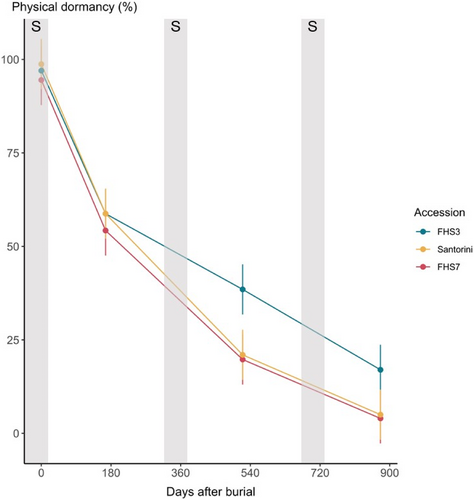
3.6.2 The patterns of release from seed dormancy in the FHS23 genotype (PY from 97ZAF5sat) co-selected for earlier flowering with parentage from cv. Cadiz
Ornithopus sativus genotypes FHS7 (PY from cv. Cadiz) and FHS23 (PY from acc. 97ZAF5sat) commenced burial with over 80% of seed in the pod segments exhibiting PY, and these genotypes could not be separated in the pattern of their subsequent release from dormancy over 3 years (see Figures 5 and 7). After 129 days in situ and an accumulated rainfall of 259.2 mm in the first winter, 53% of seed remained dormant for FHS7 and 47% for FHS23. This compares with the control species M. truncatula (cv. Caliph) and O. pinnatus (acc. 87GEH83a) which both had over 71% remaining dormant. When pockets were exhumed after 494 days (after winter 2) and an accumulated rainfall of 451.2 mm, both FHS7 and FHS23 had <10% dormant seed remaining in the pockets. There was no dormant seed remaining of O. sativus of either genotype after either 859 or 1234 days buried in situ (after exposure to 2546 mm cumulative rainfall over winters 3 and 4), whereas nearly 20% of the M. truncatula and O. pinnatus seed remained dormant at the completion of the experiment.
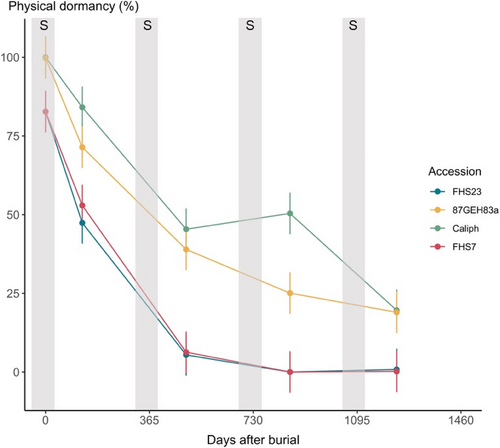
4 DISCUSSION
Domestication of agricultural plants can result in a rapid change of genotype, notably towards indehiscent seed heads, loss of anti-nutritional chemicals, increased vigour and competitiveness, uniformity in maturity and the loss of seed dormancy (Abbo et al., 2017). Some of these lost traits are now considered advantageous as agricultural systems evolve with a changing climate. Whether a process of de-domestication to re-obtain these traits is possible, is equivocal.
4.1 Ley farming and mass selection for PY
Mediterranean ley farming is considered the most sustainable form of dryland food production (Altieri et al., 2015). Current economic pressures, including commodity and input price volatility, combined with increasingly variable climatic conditions, continually challenge ley farming (Ahmed et al., 2022; del Pozo et al., 2019; Zhang et al., 2015). Under current conditions in Mediterranean Australia, ley farming is more likely economically sustainable if the pasture phase is dominated by a robust and productive self-regenerating legume (Howieson et al., 2000; Puckridge & French, 1983). Profitability is maximized if the legume pasture is sown only once every few decades, the pasture is grazed, and if unaffected by residual herbicides (Yates et al., 2024), the nitrogen fixation is sufficient to maintain the yield and protein content of at least one subsequent cereal crop (Harrison et al., 2023; Monjardino et al., 2022). Few legume species are capable of fulfilling this role, particularly on acid, coarse textured soils which receive less than 350 mm of annual rainfall, as reviewed by Howieson et al. (2000). For this reason, the search for robust pasture legumes has received attention in Australia, resulting in the domestication of several species new to agriculture since the turn of the century (Edwards et al., 2019; Harrison, Edwards, Steel, et al., 2021; Howieson, Edwards, et al., 2021; Loi et al., 2005; Real et al., 2014).
Despite the availability of this new suite of pasture legumes, deficiencies in some attributes, particularly the means to produce inexpensive seed, have compromised their adoption (Hogg & Davis, 2009). O. sativus provided scientists and farmers with a very well adapted legume; one tolerant of acid, sandy soils, low rainfall, transient drought and with a segmenting pod well suited to harvesting with cereal headers. Its agronomical weakness, in the context of contemporary ley farming, was its lack of PY, and this has now been rectified by the work presented here.
There have been previous attempts to increase PY in pasture legumes species. The useful species T. subterraneum provides an example, however attempts over half a century to significantly increase PY in this species have failed (Moss et al., 2022). In contrast, Bennett (1959) gradually increased the proportion of dormant seed in T. incarnatum L. by mass selection over a period of 9 years utilizing a similar wet paper method as adopted here. For other legume species, the PY trait has been described as heritable e.g. Astragalus sileicus L. (Syakudo et al., 1963) and Melilotus albus Medik. (White & Stevenson, 1948). In a different family to legumes, it has been reported that sunflowers (Helianthus annuus L.) have no major genes that have been identified for dormancy (physiological dormancy (PD)), but many small-effect quantitative trait loci are present (Gandhi et al., 2005). Although, a de-domestication event leading to an expression of PD in sunflower was recently reported following hybridization between a sunflower crop and its wild relatives (Hernández et al., 2022). In mirroring our own experience, those authors speculated that evolution towards dormancy from the standing genetic variation for this trait in the wild relatives of sunflower was likely to be much faster than from new mutations, especially when multiple small-effect genes are involved (Kreiner et al., 2018). We found that the mass selection for dormant seeds in populations of O. sativus, hitherto considered to be absent, revealed the presence of standing genetic variation for the trait. Importantly, this trait provided sufficient protection from germination when exposed to winter rainfall events for seeds to remain viable (and non-germinated) after three successive summers of shallow burial in the soil. Thus, a trait considered lost through domestication of the species, after hundreds of years of cultivation (Hanelt, 1997; Klinkowski & Griesinger, 1939), was restored in a form that should allow the legume broader application in ley-farming in Mediterranean dryland agriculture.
4.1.1 Patterns of dormancy alleviation in situ
Models of patterns of PY release in legume seeds have been developed by Quinlivan (1961) and later Salisbury and Halloran (1983) using temperature cabinets with oscillating regimes that are predictive of field behaviour (Taylor, 1981), but not for all legumes (Norman et al., 2006). Whilst PY in O. sativus was evident in the paper towel germination procedure, this required verification in situ. The pattern of PY alleviation in the acc. FHS7 and FHS3 (mid flowering and PY genetics from cv. Cadiz) was strongly influenced by genotype when exposed to field conditions. However, 50% of seed of both accessions remained dormant after the first summer and winter following burial in the soil and exposure to ambient conditions of diurnally fluctuating temperature and moisture. Interestingly, the pattern of dormancy alleviation from accession FHS23 (early flowering) was similar to FHS3 and 7, even though their PY genetics were obtained from different sources. For all accessions, about half of this remaining dormant seed was germinable after the second autumn. Dormant seed of the O. sativus selections continued to be recovered after 36–48 months of field exposure. In a ley farming system, this level of PY and its alleviation would enable all to reliably self-regenerate after 1 year of cropping, indicating a strong likelihood of both adaptation to, and resilience within, ley farming.
4.2 Outcomes of PY emanating from hybridisations
4.2.1 Genetic control of PY
Intense selection procedures that combined genetic sources of O. sativus allowed the successful isolation of individual plants encompassing the desirable traits of PY and early flowering maturity. Plants that provided a high probability of being homozygous for the PY trait were identified in these experiments. All F1 seed from hand pollination confirmed that the permeability of the seed coat (maternal tissue) is determined by the genotype (PY or no PY) of the maternal plant (reviewed in Smýkal et al. (2014)), regardless of the genotype of the seed embryo. Plants grown from dormant seeds in the earlier maturing accessions such as FHS23 (based upon the genetics of 97ZAF5sat) yielded highly stable expressions in PY production. However, that trait selection within cv. Emena produced a broad range of low to high level of PY, which could be attributed to disparity in seed moisture content between seeds (Hyde, 1954). Although not recorded at the time, there could have been considerable variation in moisture content between seeds in the cv. Emena population which could have created a combination of both absolute and shallow PY (Jaganathan, 2016), which would cause their patterns of dormancy alleviation to differ significantly (Jaganathan & Harrison, 2023).
The discrete inheritance of PY from the 97ZAF5sat origin appears comparable to that described for L. angustifolius and L. hispanicus (syn. luteus) (Cowling & Gladstones, 2000; Forbes & Wells, 1968). However, the more continuous expression of PY originating with the cv. Emena population is similar to that described above for T. incarnatum (Bennett, 1959).
4.2.2 Selection for maturity
Globally, as the changing weather patterns continue to cause variable rainfall and higher spring temperatures (Altieri et al., 2015), manipulating maturity in annual plants is increasingly sought to ensure their seed production before terminal drought. The intense selection for early flowering in O. sativus reduced the time to commencement of flowering after seeding in some cohorts to approximately 85 days, from approximately 120 days in cv. Cadiz. This trait also proved to be highly heritable, but in a more quantitative way than the PY characteristic. The F2 hybrids between parents of different maturity groups segregated in a normally distributed fashion and 70% of the variance could be attributed to parentage. The only exception was a broad variance in flowering time in the self-pollinated offspring of cv. Cadiz, the C1 parent in the hybridisation studies. The variability in time to flower relative to the other parents and F2 hybrids suggests that this plant was in a heterozygous state, at least for these characters. This further supports the research that cross-pollination is occurring at around 25% in seed crops of O. sativus (Nutt, Harrison, et al., 2021a). The manual pollination of O. sativus was difficult due to the small flower size, and the need to emasculate flowers to remove pollen before the stigma became receptive. Thus, there was a high rate of abortion when flowers were manipulated. Despite this, a success rate of 14% during this study indicates that hybridisation can be effectively undertaken to combine desirable characters in this species (Nutt, Harrison, et al., 2021).
4.3 Commercial cultivars emanating from this research
The selection of specific maturity classes, combined with the PY trait and a specific pattern of PY alleviation suited for Mediterranean conditions, has produced cultivars with commercial appeal. The pattern of PY release that is presented in accessions FHS7 and FHS23 has potentiated the novel method of pasture establishment termed “dormant summer sowing” (Howieson, Harrison, et al., 2021; Nutt, Loi, et al., 2021). When combined with the harvestability of pod segments of O. sativus and its other agronomic characteristics, the cultivars containing PY released from this program have largely overcome the barriers to pasture legume adoption identified by Hogg and Davis (2009) and Hackney et al. (2015). Furthermore, the cultivars have overcome the impediments to adoption presciently identified by Carter et al. (1982) which they saw emerging in T. subterraneum and Medicago spp.
The outcomes of this breeding and selection program have released to commerce medium maturity cultivars with PY dormancy that include cvs. Margurita (FHS7) and Erica (FHS3) originating from cv. Cadiz, and an early maturing cultivar with PY dormancy inherited from hybridisation with 97ZAF5sat – cv. Fran2o (FHS23). The early maturity genetics (with no PY) was released in –cv. Eliza (D1), which was the paternal parent of cv. Fran2o. The parental lines of these cultivars were briefly summarized in Figure 8.
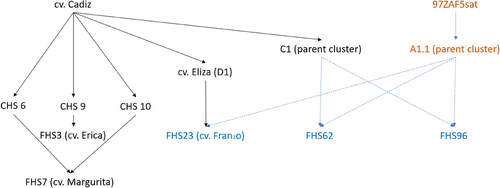
Since the initial commercial release of cv. Margurita in 2006, until the latest commercial release of cv. Fran2o in 2022, the authors estimate more than one million ha of O. sativus have been sown in southern Australia, South Africa and southern Europe (Portugal, Italy and Spain) all containing the PY genetics discovered in this research, leading to sustainable fodder and a reduction of emission intense ammoniacal fertilizers in subsequent non-leguminous crops in rotation.
5 CONCLUSION
Intensively managed agricultural environments may, over time, induce phenotypic inadequacies in cultivated plants that compromises their ability to contend with new challenges, such as an evolving climate. Physical dormancy (PY) is one such trait; it has limited value in intensive agriculture but is essential in ley farming. The research reported here details the successful de-domestication of a forage legume species to produce cultivars with climate-resilient traits. Our investigation empirically affirmed the presence of heritable PY genetics within domesticated populations of O. sativus. Through the strategic amalgamation of inherent agronomic attributes—comprising PY, early maturation, heightened plant vigour, proficient nitrogen fixation, adaptation to acidic sandy soils, and the development of harvestable segmenting pods—our research developed cultivars well equipped to perpetuate the pivotal role of forage legumes in sustainable ley farming within Mediterranean environments.
ACKNOWLEDGEMENTS
The authors would like to thank various technical support across the life of the program from Murdoch University and the Department of Primary Industries and Regional Development WA, especially at Medina Research Station. We would also like to thank Dr Emma Steel for statistical support and design, Dr Steve Carr for the acquisition of important germplasm and Prof Shahal Abbo for providing comments on an early draft. The authors would also like to thank Prof Jen McComb who supervised Dr Nutt's PhD. Finally, this work would not be possible without the support of Western Australian farmers hosting field trials. Open access publishing facilitated by Murdoch University, as part of the Wiley - Murdoch University agreement via the Council of Australian University Librarians.
FUNDING INFORMATION
This study was partially funded by Murdoch University (BN PhD scholarship), Department of Primary Industries and Regional Development, and the Dryland Legumes Pasture Systems project, which was funded by the Australian Government Department of Agriculture Water and the Environment as part of its Rural R&D for Profit program, the Grains Research and Development Corporation, Meat and Livestock Australia and Australian Wool Innovation (Project No. RnD4Profit-16-03-010).
CONFLICT OF INTEREST STATEMENT
The authors declare no conflict of interest at the time of writing.
Open Research
DATA AVAILABILITY STATEMENT
The authors confirm that the data supporting the findings of this study are available within the article. Further raw data is available from the corresponding author, upon reasonable request.



